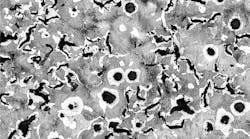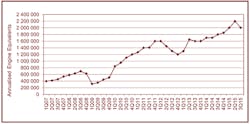SinterCast AB, the company that develops and licenses the most widely used technology for processing compacted graphite iron, reported a third-quarter 2015 (July-September) revenue of SEK 20.6 million ($2.35 million), with year-to-date revenues rising to SEK 55.2 million ($6.3 million.) The group noted that the current year-to-date revenue total surpasses its previous record for annual revenues, during a cycle that has seen six new commitments by foundries for new SinterCast system installations — matching its previous high total.
Stockholm-based SinterCast is the world’s largest supplier of the control technology used by foundries to produce compacted graphite iron (CGI) -- a lightweight alternative to gray iron and aluminum for automotive components.
In a note accompanying the quarterly statement, SinterCast president and CEO Dr. Steve Dawson called attention to a strong rebound in CGI series production during September, following summer shutdowns as several important licensees.
“The annualized series production for the third quarter amounted to 2.0 million engine equivalents (i.e., 50 kg), providing an 11% year-on-year increase for the third quarter and a 19% increase in the year-to-date production volume. In parallel with the growing production, 112,000 sampling cups were shipped during the first three quarters, representing a new record for the company,” Dawson stated.
He explained that the current results have benefitted from increased series production, increased sampling cup shipments, and increased installation activity, all compounded by favorable exchange rates. “Together, the progress has resulted in a 54% increase in year-on-year revenue, with the revenue for the first three quarters of 2015 surpassing the previous full-year revenue record established in 2014,” according to the president/CEO.
SinterCast’s progress in expanding series production of CGI for diesel and gas engines has been notable during 2015, with five new commitments during the first half of the year and a sixth during Q3 from Teksid’s Brazilian foundry operation.
The outlook for new series production continues to be positive, the group stated, in light of the number of CGI applications for light trucks (Ford, Nissan) and passenger cars (Ford.
Series production of CGI for industrial power applications also contributed to the positive 3Q results for SinterCast, up 40% versus 2014. “This growth was primarily derived from the continued increase of the General Electric locomotive cylinder head,” according to the release, “and also benefitted from the start of production of the new Cummins QSK95 industrial power engine during the quarter.”
The group reported it continues to develop its ductile iron process technology, focusing on the design of a customized thermal-analysis sampling device, “and on foundry trials to optimize the metallurgical correlations.” SinterCast’s objective is to help ductile iron foundries cut magnesium consumption, improve mold yield, reduced casting defects in the foundry, and improve machinability.










